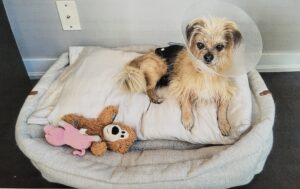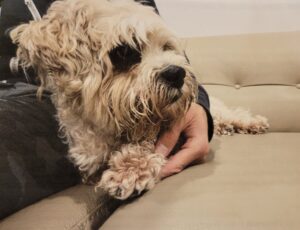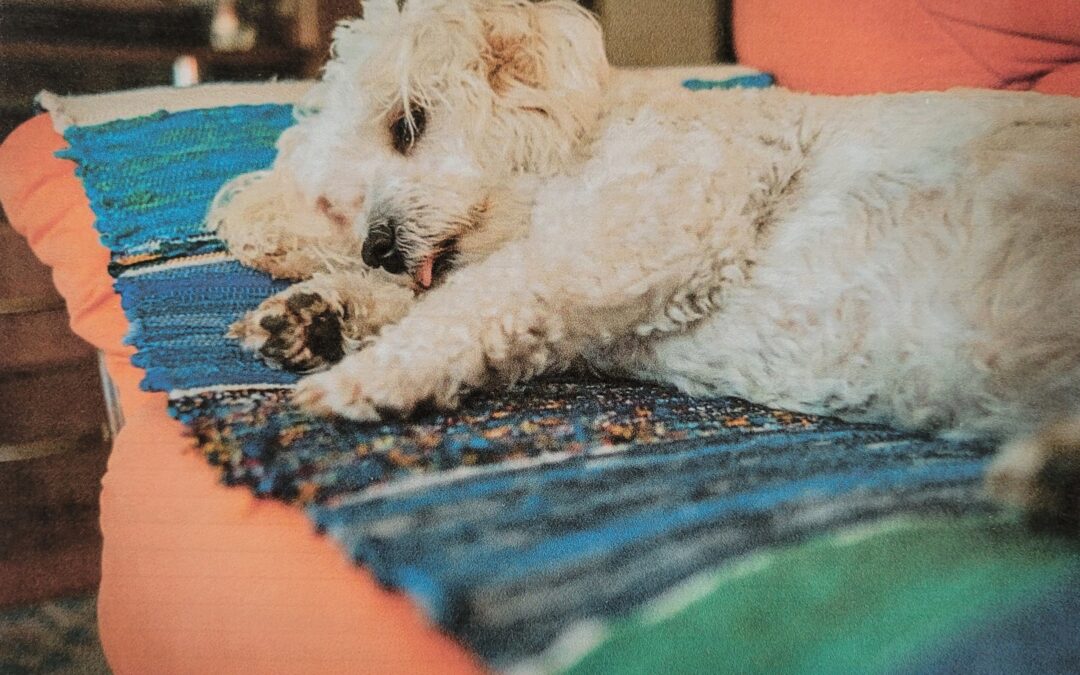Why is My Dog Chewing Their Paws
Is your furry best friend chewing their paws all day? Chewing for self-grooming can be a normal and healthy part of your pet’s routine. But it becomes a problem when the chewing is excessive and causes bleeding, swelling, or irritation.
If that is your dog’s case, chances are that they are dealing with paw injuries, pain, allergies, skin problems, or behavioral issues.
In this article, we explore in detail each of these causes and how you can help your dog avoid chewing their paws excessively.
1. Paw Injuries
First, start by inspecting your dog’s paws, especially if they are only licking one spot in particular. They may be trying to clean a wound, remove objects stuck in the pad, or relieve pain.
Some common paw injuries are:
- Cuts
- Objects stuck in their paws, such as thorns, and debris
- Burns
- Irritations caused by walking on salty, icy, or hot surfaces
- Blisters
- Abscess (it is a painful swelling filled with pus)
- Insect bites
- Frostbite
- Overgrown nails
- Torn nail
In case of minor wounds, you can assist them at home by rinsing the area with sterile saline solution to wash away dirt, saliva, or bacteria, and then wipe it working from the center of the injury toward the edges.
If you are dealing with a large and bleeding wound, then your priority is to stop further bleeding and seek veterinarian help immediately. To control the bleeding, apply pressure using a clean pad while you transport your dog to the vet clinic.
For insect bites, trim the fur from around the wound, and rinse with saline solution. Check for signs of redness, swelling, and discharge as these may require vet attention.
In case of small and superficial burns, treat it by rinsing the area with cold water for at least 10 minutes, then apply Aloe Vera three times a day, and ensure your dog does not lick the area. If the burn is large or deep, then after running the area under cold water, seek veterinary help.
You may need to cover the wound to prevent your dog from licking, to do that you can use a dressing but make sure to change it daily to reduce the risk of infection. Additionally, you may need to make your dog wear a cone.

Here is one of my boarding dogs wearing his “cone of shame” to prevent licking
2. Chronic Pain
Some conditions such as arthritis cause chronic pain when the pet is not receiving treatment.
The pain may not necessarily be at the paws, but dogs may be chewing them as a self-soothing mechanism.
The solution in these cases, is to manage chronic pain through physical therapy, exercises, supplements, and anti-inflammatory pills if needed. This condition is highly prevalent in dogs older than 8 years, but fortunately, there are many strategies to help a senior dog with arthritis.
3. Allergies
Allergies are an overresponse of the immune system after being in contact with an allergen.
These can be foods such as animal proteins, or environmental conditions such as certain plants, insects, pollen, mold, chemicals, etc. Symptoms may include itchy skin, hives, swelling, vomiting and diarrhea.
The treatment may involve a combination of:
- Antihistamines to block allergic reactions, such as Benadryl or Piriton (only for dogs, never for cats).
- Shampoo therapy to reduce itchiness and inflammation.
- Changes in diet and supplementation with omega-3 and 6 oils.
4. Fleas
Fleas are small parasites that feed from your dog’s blood and cause extreme itchiness and discomfort. They like to hang behind the ears, armpits, and chest. You can also spot them on your dog’s bedding and clothes.
To treat fleas, you can try:
- Using flea prevention products, such as topical treatments or oral medications. Always under the supervision of your veterinarian.
- Regularly washing your dog’s bedding and vacuuming the house to remove any fleas or eggs.
- Grooming your dog regularly to check for fleas and remove any that you find.
- Treating your home and yard for fleas to prevent re-infestation.
5. Behavioral Factors
Many behavioral factors could be influencing the paw chewing problem, for example, anxiety, stress, boredom, or compulsive disorders. Similarly to humans, dogs also have their coping mechanisms to deal with these emotions, and this could be chewing their paws.
To address behavioral-related paw chewing, consider:
- Identifying the source of distress and reducing the exposure.
- Providing a calm and secure environment where your dog can retreat when he or she needs a break.
- Engaging in regular exercise and mental stimulation.
- Using calming aids such as pheromone diffusers or CBD.
Symptoms and Signs to Look For
You can tell apart normal grooming behavior from an underlying issue by paying attention to these signs:
- Your dog is constantly licking and chewing their paws throughout the day.
- There is redness, swelling, or irritation on the paws.
- There are changes in the color of the paw’s fur, or fur loss.
- There is bleeding, open wounds, or infections.
- Your dog is showing behavior changes, such as looking unease, pacing, or crying.
- There are wet spots on their bedding as a result of the excessive licking.

This is Mickey, his fur color changed after excessive licking due to an allergic flare-up.
Preventive Measures and Paw Protection
- Keep a bowl of water and a towel near your entryway to clean their paws after every walk.
- Trim the nails periodically and the hair around the paws.
- Moisturize your dog’s paws regularly, using a dog paw balm.
- Use winter boots to avoid contact with salt and other chemicals used to melt the ice.
- Avoid going out during the warmest time of the day during summer.
When to Seek Veterinary Assistance
It’s always a good idea to seek professional help, but in case you are wondering if the problem is worth a visit to the vet, here are some warning signs to watch out for:
- The symptoms persist or worsen even after you have tried home remedies and preventative measures.
- There are signs of infection, such as pus, foul odor, swelling, or severe discomfort.
- If the root cause is a specific condition or a complex case, for example, arthritis, fleas infestation, or allergies.
Final Thoughts
If you suspect your dog is excessively chewing his paws, look out for warning signs such as redness, inflammation, swelling, bleeding, pain, changes in fur (color or bold spots), and changes in behavior. The first step is to identify the root cause, to address it accordingly.
Many of the reasons can be addressed or prevented at home, but more complex cases will require vet intervention. In any case, don’t leave it untreated because this behavior affects your pup’s well-being.
FAQs
How do I stop my dog from chewing his paws?
The key is identifying the underlying problem first, as there are many causes for this behavior. Depending on the root cause, you can try different strategies including allergy management, regular paw maintenance, parasite treatment, addressing behavioral issues, and chronic pain management.
Are there home remedies to stop dogs from chewing their paws?
Yes, there are home remedies that you can try, such as oatmeal baths, chamomile tea rinses, or coconut oil to soothe, reduce inflammation, and calm itchiness.
References
https://www.akc.org/expert-advice/health/why-does-my-dog-lick-chew-paws/
Submitted by:
Katherine, content marketing strategist, and dog lover with +10 years of experience in dog boarding. I combine my love for dogs and writing and Furryaging.com
Find out how you can keep your pets healthy in the winter on our website Pet Parents Place

